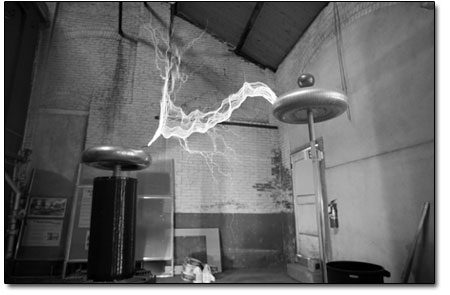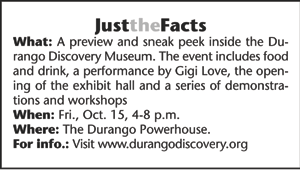|
| ||||
| The voyage to Discovery
by Brandon Mathis
The museum’s mission is to ignite curiosity, spark imagination and power exploration. “We’re hoping to turn this place back into an energy generator, not just traditional energy, but to get us thinking and to power our minds,” said Haz Said, Director of Marketing and Communications at the Museum. The building and its separate hundred-foot smoke stack are now on the National Register of Historic Places. The building once generated ample electricity from coal-fired steam but ceased operating in the early 1970s. For almost four decades, it was an eyesore on a parcel of typically coveted downtown riverfront property. Now, it is the last structure of its kind still standing in the nation. “It was practically condemned,” said Said. Nearly a decade ago, the Museum, then the Children’s Museum of Durango, started looking for a new home, having outgrown its space at the Durango Arts Center. Members of the museum’s Board of Directors looked in the direction of the Powerhouse. When entities like Colorado Preservation Inc. and the State Historical Society got onboard, a preservation plan was developed. Now, eight years and more than $1 million of fund-raised rehabilitation later, the Discovery Museum has a new home. The local community has shown encouraging support, in a number of fashions, from outright donations to the purchasing of bricks in the courtyard. “There’s broad support for the project because our mission addresses so many interests,” Said said. “Historic preservation, energy issues, science and math education, early childhood learning, economic development and river front revitalization. We’ve made sure there are ways to contribute at many levels, from volunteering, to large scale financial sponsorship.” Now approaching its second phase of development, the staff is focusing on creating an interactive learning facility for all ages and looking ahead to the future. After-school programs are already in place, and outreach programs, like the Solar Roller – a mobile power station – are traveling to outlying communities. “We fill an important role: informal learning for kids that might not be getting the level of exposure that they need,” said Said. Lexie Wallace, education manager, noted that the Discovery Museum will be geared toward providing a sanctuary for continual learning at all levels and nurturing young minds with new ideas. “We are a quirky and geeky staff, and we have a home here,” she said. “Parents needing an interactive minds-on play space have a home here. History buffs and cultural junkies have a place to explore.” She added, “It’s a fluctuating project. We’ll embrace different people’s interests and aspirations – sometimes with heavy historical metal, sometimes with icky sticky slime, and sometimes with enlightened toddler eyeballs.” Most of the exhibits in the museum will be hands-on, inviting curious hands to touch, experiment and learn.
“Traditionally, museums are highly curated collections behind glass, but interactive science centers are all about learning by doing,” said Said. “Our slogan is ‘the power of fun,’ and learning in our museum comes from experimenting – actually being able to touch stuff, see how things react.” According to Wallace, a few larger exhibits promise to make lasting impressions on inquisitive minds of all ages. One exhibit called Magic Planet will allow visitors to upload satellite images of Earth and other planets, and project them onto a spherical screen, or globe, using data from NASA and NOAA. “Everybody will gather around this one. If you wanted, you could see storms on Mars,” she said. The Environmental/Energy “E” Tree will allow younger visitors to climb around and wander safely through solar mirror leaves, or explore the Discovery Kids Zone underneath, with smaller, hands-on things to mess with. A three story “kaleidoscope of mirrors” will reach the ceiling and capture sunlight to be utilized to power things below that require electricity. “You can manipulate the mirrors however you want to increase the voltage you are experiencing on the bottom with a variety of solar exhibits,” Wallace said. People can then use the energy to power things like electric cars, or pop popcorn, she explained. Wallace added that the exhibits can be used to prompt discussions and develop scientific reasoning skills. “We’ll be using them for discussion with school groups and other visitors,” she said. “What is scientific data? Where do we get it? We want to get people to think about the past, but also about the future of the climate, the Earth and the environment.” The museum’s overriding theme is energy and teaching about the beginnings of modern power, the basic scientific properties that power today’s world and future possibilities that can be explored. “We want the museum to be a hub for learning,” said Said. “We have some really interesting things on photosynthesis and sun power, and others will be the basics: playing with magnets and building robots. We’re hoping that this is sort of a hotbed for kids to go ‘Hey, what if we did this?’” What will show through all of the exhibits and activities is the museum’s underlying commitment to Durango. “What we offer is twofold,” Wallace said. “We are bringing unique science, engineering and math opportunities to a population of people that don’t have them. We are connecting downtown with the river front, which seems huge to me.” The Discovery Museum’s final phases will include a large complex of science and technology centers, including a series of outdoor exhibits, activities and amenities along the Animas River. “We’re pushing people to think outside the box,” Wallace said. “The kids in our Lego League are already programming computers, finding circumference and using Pi and other mathematical calculations, and they are 9. I think we’re really pushing human potential.” The restoration project will also continue with sustainable upgrades and operation on site as the Discovery Museum prepares for its final “hard opening” in coming months. “This place will be full of exhibits,” said Said. “The main focus of this place is to inspire. Wouldn’t that be neat if we ended up with a few Nobel Prize winners?” •
|
In this week's issue...
- May 15, 2025
- End of the trail
Despite tariff pause, Colorado bike company can’t hang on through supply chain chaos
- May 8, 2025
- Shared pain
Dismal trend highlights need to cut usage in Upper Basin, too
- April 24, 2025
- A tale of two bills
Nuclear gets all the hype, but optimizing infrastructure will have bigger impact



 The Durango Powerhouse is about to start generating a new kind of power. The building constructed in 1893 to provide electricity to Durango is coming back to life as the long-awaited Durango Discovery Museum. The public will have a sneak peek Oct. 15.
The Durango Powerhouse is about to start generating a new kind of power. The building constructed in 1893 to provide electricity to Durango is coming back to life as the long-awaited Durango Discovery Museum. The public will have a sneak peek Oct. 15.